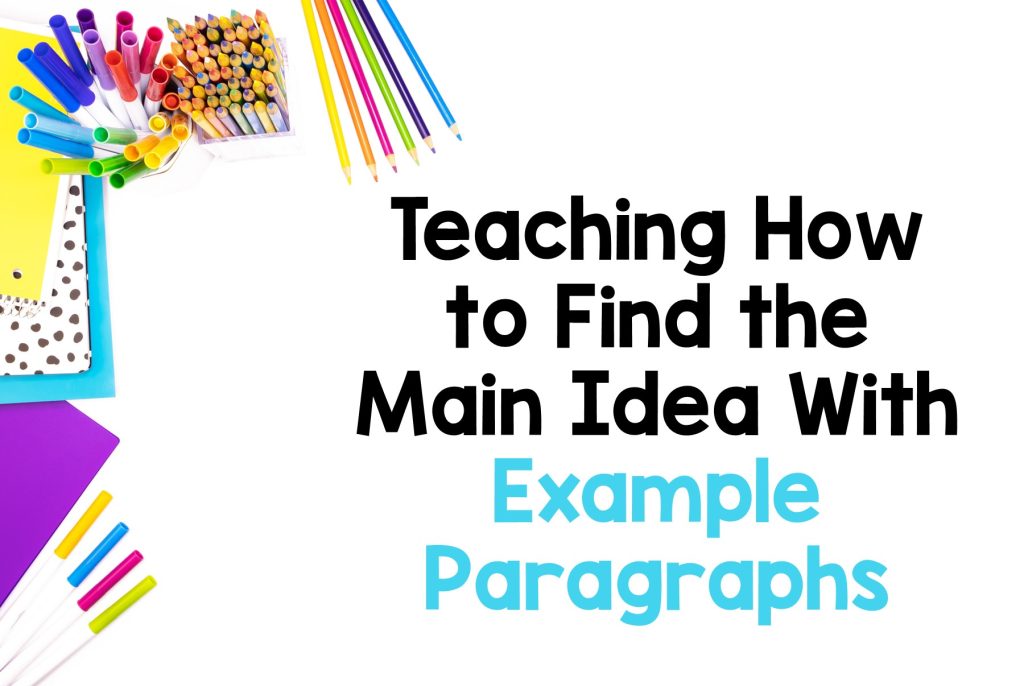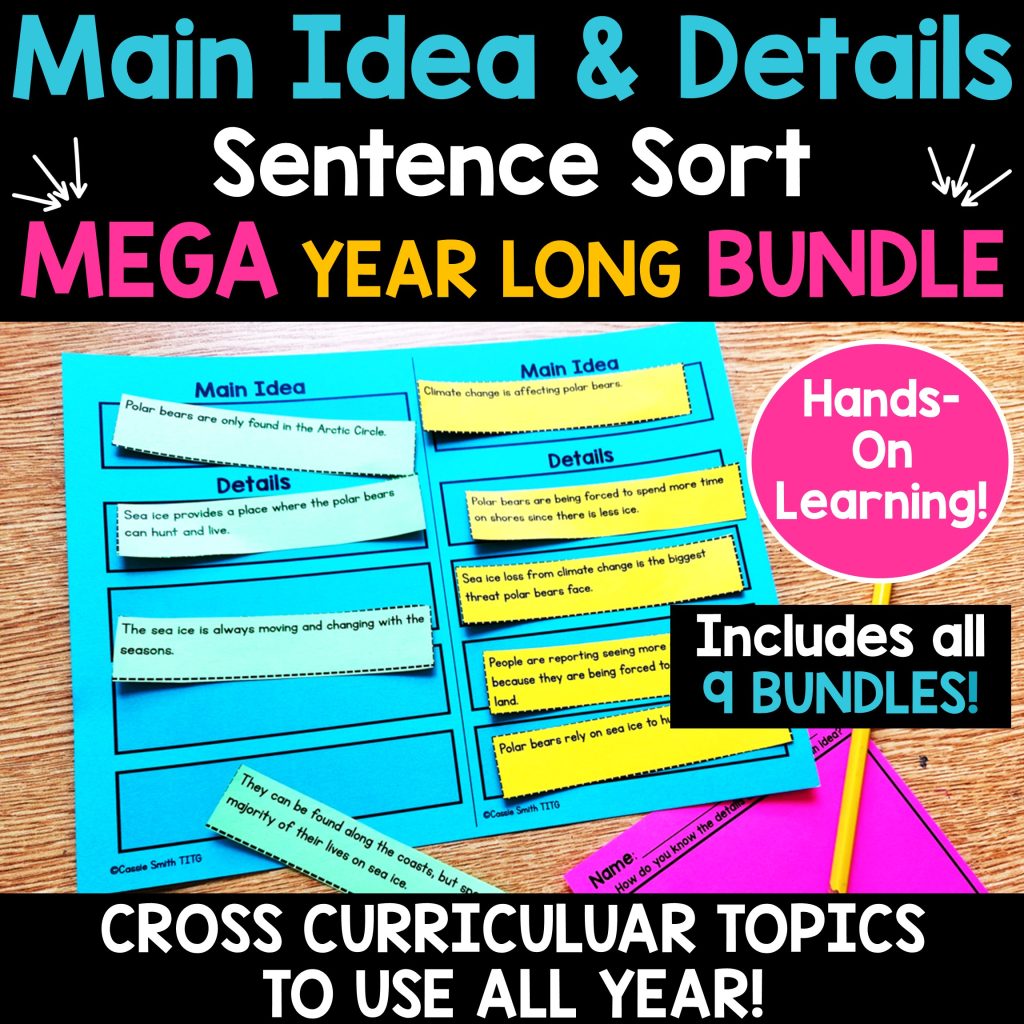Teaching students to find the main idea of a paragraph can feel like watching them search for their lost pencil. IT’S RIGHT THERE! But somehow, they just don’t see it. ✏️😆🤦♀️
Sometimes your students might latch onto a tiny detail, pick a random detail sentence, or just shrug and guess. So I’m going to share with you some strategies they can learn to identify the main idea, whether it’s clearly stated or needs to be inferred.
Let’s walk through how to teach main idea (also known as the central idea) with example paragraphs, strategies that make sense to young readers, and activities to help it stick!

1. Where can we find the main idea in paragraphs?
Students often expect the main idea sentence to be in the first sentence of the paragraph. And while that’s sometimes true, it’s not a guarantee. They need to check the rest of the paragraph and determine the topic of the paragraph to make sure the other sentences actually support that idea.
Here’s an example where the main idea IS in the first sentence:
“Elephants are the largest land animals on Earth. They can weigh up to 14,000 pounds. They can grow as tall as 13 feet. Their large trunks help them eat, drink, and even greet other elephants. These gentle giants are known for their intelligence and strong family bonds.”
📢 Ask your students: What’s the most important idea? The first sentence tells us: Elephants are the largest land animals on Earth. Everything else supports that statement.
Now, let’s look at a paragraph where the main idea is in the LAST sentence of a paragraph:
“Brightly colored feathers, loud calls, and playful personalities make parrots one of the most entertaining birds to watch. Some parrots can even mimic human speech. They are intelligent and social animals. They often form strong bonds with their owners. Because of their ability to learn and interact, parrots make popular pets.”
👉 The last sentence states the main idea: Parrots make popular pets. The rest of the paragraph builds up to that conclusion.
But what if there’s no clearly stated main idea? Sometimes, students have to infer it from the group of sentences. (This usually is something you’ll encounter if you teach upper grades.) Read the following paragraph and see if you can figure out the implied main idea.
Here’s an example of INFERRING the main idea:
“Rainforests are home to over half of the world’s species. These dense, tropical forests provide shelter, food, and resources for countless animals, from tiny insects to massive jaguars. The warm climate and high rainfall create an ideal environment for life to thrive. Without rainforests, many species would struggle to survive.”
📢 Ask: What’s the main idea of the paragraph? Even though there’s no explicit sentence, we can infer that the main point is rainforests support a vast number of species.
👀 Why does this matter? Because students love to grab the first sentence and run with it. Teaching them to read the whole paragraph and check how the details connect is a game changer!
2. Teach Students to Look for Supporting Details
One of the biggest mistakes you might notice your students make? They latch onto a minor detail instead of the most important idea.
To help, teach them to:
✅ Look for repeating words or related words throughout the paragraph (have them highlight or underline the repeated words or ideas)
✅ Check if the supporting details actually connect back to a single idea
✅ Try rewording the most important sentence in their own words. (Sometimes writing the main idea as a complete sentence helps them figure it out! Especially when it’s their own writing and not just a copied sentence.)
Here’s an example paragraph to practice with:
“Tornadoes are powerful storms that form when warm, moist air meets cold, dry air. These swirling funnels of wind can destroy buildings, toss cars, and uproot trees. Some tornadoes last only a few minutes, while others can continue causing destruction for hours. The strongest tornadoes can have winds over 200 miles per hour.”
📢 Ask: What’s the main idea of this passage?
If students notice repeated ideas like tornadoes, storms, wind, destroy, destruction, they’ll realize that the main idea sentence would be: Tornadoes are powerful and destructive storms.
3. Practice With Different Paragraph Structures
Students need to see example paragraphs in different formats to feel confident finding the main idea of a paragraph.
Some fun ways to practice:
📌 Slips of paper: Write paragraphs on cards and have students sort them by main topic
📌 Fun game: Give students a paragraph without a main idea sentence and challenge them to write one
📌 Task cards: Have students highlight the main idea sentence in a single paragraph
📌 Main idea and details sentence sorts: Organize sentences from a paragraph on a graphic organizer to determine the main idea and supporting details (try one below!)
👩🏫 Teacher tip: Use real-life informational text like short news articles, social studies passages, or science texts for close reading practice!
4. Common Mistakes Students Make (And How to Fix Them)
🚫 Thinking the beginning of the paragraph is always the main idea
🚫 Choosing from one of the minor details instead of the central idea
🚫 Struggling with implied main ideas
🛠 How to fix these mistakes:
✔️ Teach students to double-check that the rest of the paragraph actually supports their choice
✔️ Have them rephrase the point of the paragraph in their own words
✔️ Create an anchor chart for students to refer to when they work on this skill
Finding the main idea of a paragraph is a skill that takes practice. With engaging activities and plenty of example paragraphs, your students will get better at it!
💡 What’s your favorite way to teach main idea? 🎉
Need More Main Idea Paragraphs for Practice? Get Main Idea and Details Sentence Sorts for the Classroom!

Learn About Teaching Cause and Effect


